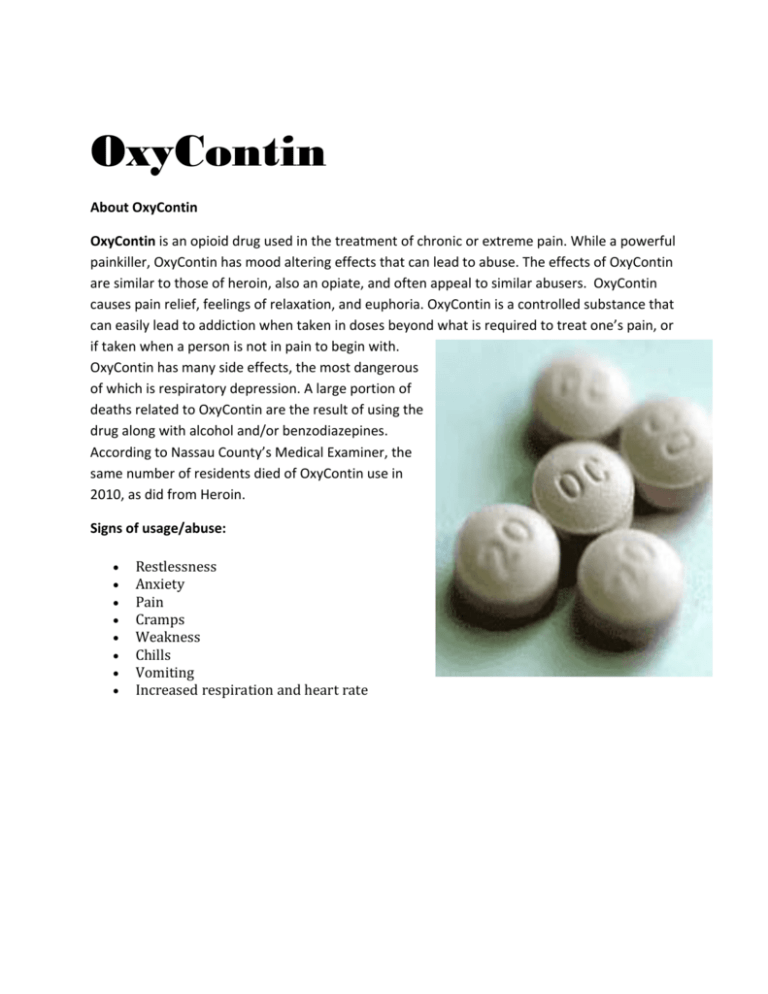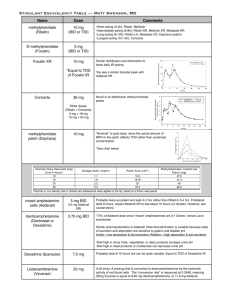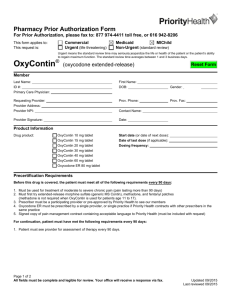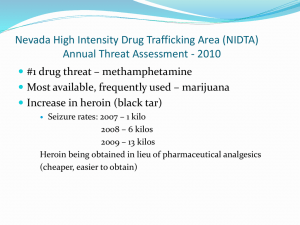OxyContin
advertisement

OxyContin About OxyContin OxyContin is an opioid drug used in the treatment of chronic or extreme pain. While a powerful painkiller, OxyContin has mood altering effects that can lead to abuse. The effects of OxyContin are similar to those of heroin, also an opiate, and often appeal to similar abusers. OxyContin causes pain relief, feelings of relaxation, and euphoria. OxyContin is a controlled substance that can easily lead to addiction when taken in doses beyond what is required to treat one’s pain, or if taken when a person is not in pain to begin with. OxyContin has many side effects, the most dangerous of which is respiratory depression. A large portion of deaths related to OxyContin are the result of using the drug along with alcohol and/or benzodiazepines. According to Nassau County’s Medical Examiner, the same number of residents died of OxyContin use in 2010, as did from Heroin. Signs of usage/abuse: • • • • • • • • Restlessness Anxiety Pain Cramps Weakness Chills Vomiting Increased respiration and heart rate Vicodin About Vicodin Vicodin is one of many brand names for the combination of acetaminophen (Tylenol ) and hydrocodone—a potent morphine-like cough suppressant and opiate analgesic. Acetaminophen halts the production of prostaglandins which otherwise cause pain. Hydrocodone works by binding to the pain receptors in the brain to deaden the sensation of pain. Long-term intake of Vicodin over months, though initially prescribed for moderate to moderately severe pain, may cause a Vicodin dependency. Vicodin is an opiate drug and its effect on the receptor sites mimics heroin. People with opiate dependency may not necessarily encounter the same social behavior as so-called ‘drug addicts’, but do experience the same symptoms with withdrawal. Signs of usage/abuse: • • • • • • • • Unbearable pain Cascade of bodily reactions Cold sweats Uncontrollable diarrhea Nausea and vomiting Aching limbs Severe depression Distress and a mounting panic. Xanex About Xanax Xanax is the trade name of a drug called alprazolam, originally manufactured by Pfizer. It is currently marketed under the generic name by several companies and the pills come in a variety of colors and shapes. Xanax is a drug in the benzodiazepine family (others include Valium, Librium, and Restoril) and is used to treat anxiety. Xanax is sometimes taken, not by the person for whom it was prescribed, but by someone intent on getting the relaxed state it produces. This is especially dangerous when it is taken in combination with alcohol or opiates to get a more intense ‘high’. Benzodiazepines in combination with alcohol have led to deaths from respiratory depression. In some cases, Xanax has even been used as a "date rape drug". This is because it has a relatively sudden onset (1 – 2 hours), has stronger effects when mixed with alcohol, and has a side effect of memory loss. The criminal intent is to make the victim cooperative and to have them forget any details of the rape. Signs of usage/abuse: • • • • • • • • • • • • • Nausea, vomiting, or diarrhea A rapid heartbeat (tachycardia) Heart palpitations Hallucinations Memory loss Dizziness Personality changes Sensitivity to sound or light Depression Insomnia Restlessness or irritability Confusion Sweating Dextroamphetamine About Dextroamphetamine Dextroamphetamine (Dexedrine) is an amphetamine, belonging to the group of medicines called central nervous system (CNS) stimulants. It is a Schedule II controlled substance. Dexedrine was often used in the late 60s and early 70s as a prescription diet aid, because one of the effects of such stimulant drugs is to suppress appetite. Dexedrine (and its more potent cousin Benzedrine) was also commonly (and illegally) used by college students, either for the stimulant high it provided or as a study aid. This drug works by suppressing all spontaneous behavior. Dexedrine reduces all spontaneous or self-generated activates which is shown by the following characteristics: exploration and curiosity, socializing, and an increase in obsessivecompulsive behaviors. Signs of usage/abuse: • • • • • • • • • • • • • • • • • • Abdominal cramps Coma Confusion Convulsions Depression Diarrhea Fatigue Hallucination High fever Heightened reflexes High or low blood pressure Irregular heartbeat Nausea Panic Rapid breathing Restlessness Tremor Vomiting Adderall About Adderall Adderall use can slide easily from abuse to addiction because of the way the drug acts on the brain. Like other amphetamines, it stimulates a part of the brain sometimes called the Pleasure Center and causes a release of potent neurotransmitter chemicals. But the same stimulants also prevent the neurotransmitters from being reclaimed and re-used normally by brain cells, so that the user feels the need to take more and more Adderall to re-create or sustain the rush. Some people are at greater risk than others for becoming addicts; risk factors include a family background of alcohol or drug abuse, stressful circumstances that the drug seems to alleviate initially, and individual emotional or personality traits. Signs that an Adderall user has crossed the line between abuse and addiction include: Signs of usage/abuse: • • • • • • Increasing tolerance to the drug, which makes it necessary to take more Adderall to achieve the same effect; Snorting, smoking or injecting the drug (rather than taking it orally as indicated) for a “quick fix;” Dependence on taking Adderall simply to feel normal and cope with everyday situations, to the point where discontinuing the drug seems impossible; Making access to Adderall a priority ahead of other concerns such as friends or work; Resorting to theft or other illegal means to get Adderall; Continuing to abuse the drug in the face of negative consequences and damaging side effects.







